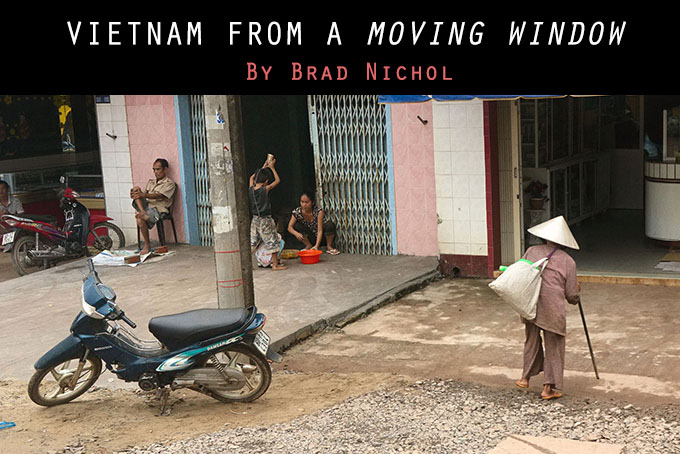
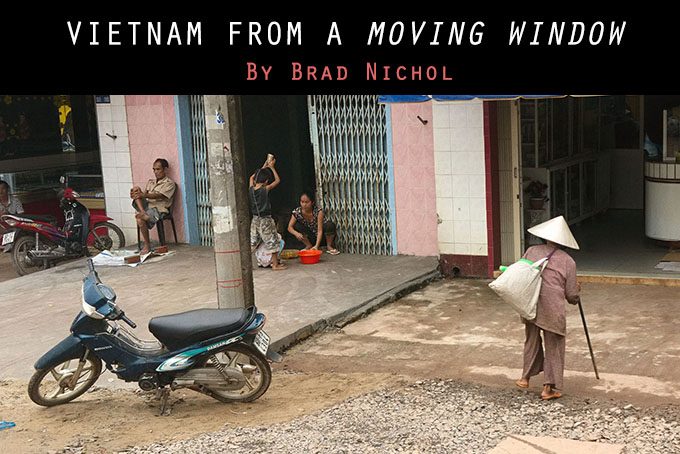
Vietnam From A Moving Window
By Brad Nichol
Three years ago, my lovely wife and I sojourned to Vietnam on tour with 25 other people. Now please note I said with 25 other people! No, this was not a photo tour, just a regular tour for regular folk toting compacts and camera phones and if my memory serves me right just 3 DSLRs. My wife said before we went, “you’ll be that guy, you know, the one who holds up everyone else as he gets all engrossed hanging off trees, crawling on the ground and zoning out while taking his photos”. I knew what she meant of course and having never been on an organised tour before I had some doubts as to how I would cope with the unending bouts of “photos interrupts” and let me just say, there was no stopping the bus just so I could get that special shot….. absolutely no possibility of that at all.
You see, Vietnamese roads are not blessed with pull off spots for big yellow buses, usually stopping a bus would mean all the traffic stops in both directions, horns then get very horny and wiry angry men start swearing at you…..in Vietnamese! In any case, the time was simply not there, for those who have never ventured to Vietnam this might sound odd, but a modest drive just 150 km can take 8 hours! Non-programmed stopping would decimate any intended schedule for a tour group. To be fair, I was just one of 27 so an alternative approach was needed, the world does not revolve around me, unfortunately. My bus travel photography technique involved throwing out the bus window pretty much all approaches I had ever had towards my work. No careful framing, no use of low ISOs, no changing lenses (or even the focal length most of the time), no control of the subject, no waiting for the right light, no direct control of viewpoint. Hell, it’s enough to turn an anal retentive shooter like me into a spasm racked blithering mess of muscle and blubber (more blubber than muscle). So here’s what I did instead to avoid a total melt down…. I got drunk….no, not really but those cheap Vietnamese beers were a nice reward at the end of a hot humid day.
This is what I actually did… Said hello to 800 ISO and even 1600 ISO, it’s not so bad after all, but where possible I shot at 400 ISO which was altogether better quality wise. Bear in mind I was using a Sony NEX 5N at the time, sensor technology has moved forward considerably since then and 1600 ISO these days is probably as good as my 400 ISO was then! Stuck with *27 mm focal length on my NEX 18-55 kit zoom and gave all my other “real” lenses a nice little rest in the camera bag. Fixed the aperture to f6.3, which I do more often than not anyway with APSC, these days f5 on my m4/3 gear has become the new “go to hole”. Fixed the focus to about 4 metres. The acceptable DOF at 27 mm runs from about 2.4 to about 13 metres at f6.3, which is fine when you’re shooting stuff that is just outside the bus as you fly past, sometimes I would shift the focus a little further out if we were out of town or in areas where all the action was generally further afield. Fixed the white balance for the prevailing conditions, which is not too hard as I never use that auto WB setting. I think AWB stands for “Always Wrong Brad”. Of course as I shoot “RAW only” the WB can be sorted in post but getting the WB reasonably close at shooting time gives me a useable point of reference as far as the colour goes. I will add my Olympus EM5 mk2 seems to be much better on AWB than the NEX ever was.
Fixed the mode to **manual and thus fixed the shutter speed so as to not burn out the highlights for the given lighting conditions. Much as I can accept compromises I can’t accept the highlight burnies and when the lighting conditions are rapidly changing on the fly as you whizz past auto exposure will often completely mess things up. Basically you could say I expose for the highlights and let the shadows fall where they will, to my mind this allows me to create a more filmic and 3D look in post. I will admit that late one day on the this tour I was caught out by a combination of a sudden torrential storm and scenes that were inside darkened doorways and messed up, thank goodness the little Sony had a reasonably forgiving sensor for its’ time.
These days you could probably use aperture priority and dial back the compensation a bit as insurance knowing the improved dynamic range and noise characteristics of modern sensors will see you through.
So once set up I just shot at anything that looked a bit interesting as we sailed on by. I used the same techniques for shots taken whilst on boats cruising along the river through markets, fish farms and other classic Vietnamese photo ops, the method used for Pedicabs was similar and I even shot photos in markets and alleys whilst on the move without even looking through the viewfinder using a version of the above (Pics from the last method are not included in the article, that’s worth another article and it’s a method I now regularly use.)
Yes sir I was running a free wheeling digital lottery approach, not even sure of what I had until I got to load all the shots on the Mac Meister once back home in OZ. I did play with about 15% or so of the pics on the trip, so I could share with my tour companions on our last day together.
So in the editing phase…
Did I need to crop? Of course, but that’s hardly a challenge these days and even the old NEX 5n’s now paltry 16 mp offered plenty of flexibility.
Did I need to brighten some things up? Of course, but I should note that I never had an unintended clipped highlight zone.
Did I need to adjust the colour? A bit but mainly because the bus windows tinted things up somewhat and made judging perfect white balance tricky. (One serious trade off with shooting through tinted bus windows is that your exposures will exhibit poor red channel response as most tints knock out the red wavelengths disproportionately, this makes editing a little trickier and makes the image noisier.)
Did I get noise, sure, but then it was either that or nothing at all and at reasonable sizes the noise is fine, in any case its much better than what you would expect from your smart phone – even today. Did I get some good shots, well that’s open to opinion, but I believe I got some nice results and here’s why…. Shooting from a fast moving window of opportunity forces you to examine composition very quickly, it concentrates shot timing, with mere seconds being broken down into tiny slithers of time, all of which offer distinctly different compositional possibilities, it forces you to choose NOW, Right NOW! ……..And it offers the joy of unpredictability. Of course there will be many duds, false fires and marginal results, there’s no promise of ***perfect sharpness or exposure, but when you play the numbers with considered intent, controlling what you can, accepting what you can’t, there’s always the possibility of a compelling photograph or two.
I also shot a lot of “street style” photography whilst in Vietnam, I enjoyed it immensely, but what I found interesting was that the images taken from the moving windows of boats, buses and pedicabs brought something else to the table that regular street shooting didn’t, “The total obliviousness of the subject being photographed”. The subjects took no pose, nor adjusted their stance and expression, they had no time to respond even if they did see me, but mostly they were simply, completely, utterly, unaware. On the occasions they did become aware of being photographed they had too little time to change their demeanour and on a couple of occasions the sudden “half aware direct contact with the cameras lens” created an additional point of interest.
Another factor also added to the mix, the changed viewpoint of sitting high up in a bus, it gives a different visual insight compared to the pics from pedicabs and boats. The elevated perspective means you can see into the more three dimensional spaces around the core subjects, spaces that would normally be blocked from view by bodies and other objects, this allows you to better see relationships in both form and story. A couple of the pics in this set were taken from Pedicabs and I am sure it will be obvious that they have a different dynamic.
To me the rendered images are little slices of life as lived upon the streets, I feel they captured the essence of Vietnamese street trade and relationships, for example Men playing board games and drinking coffee, whilst the women worked in the background.
A fascinating aspect of the Vietnamese streets is that you see so many contrasting elements in close proximity to one another, someone fixing motor bikes 3 metres away from a food stall with others chilling out on motorbikes just another 3 metres down the road.
What really struck me was that in each frame I could see a number of stories or possibilities, crop the frame or move it around a little differently and the viewing channel changes, this flexibility initially led me down rabbit hole of random cropping and frustrations. Decisions… decisions!
For me the images serve a very personal purpose, they bring to mind all the things that my wife and I saw and experienced in an honest way, they were taken for us, it was only much later that I thought about sharing them with my students and readers.
Viewed retrospectively it is the little things I notice most: Men seem to sit around more, women generally seem more involved in activity, the ubiquitous small red chairs, the role of the motorbike (a supreme possession, freedom machine, and valued workhorse), the prevalence of smoking, the observational looks where time being passed whilst doing nothing is not wasted time at all, random social activities, hard work with so little in the way of tools, the of course the ingenuity and happiness of the people.
All up I ended up with about 150 keepers in the “From Moving Windows Set” here I have pulled together a subset of 24 images that fitted the cinematic framing format, actually 17:9 (just a bit wider than the standard 16:9 format) but I have other groupings of square pics and closer up images and pics of differing themes.
Ultimately what I was trying to tell a story through a series of images, they are all part of a whole rather than individual frames and I have designed a large scale artwork for my home audio room that uses all of these frames and a few others as well in combination. That artwork will be completed in the coming January, it’s not dissimilar to this large scale artwork I created three years ago, you might like to take the diversion to check that one out.
Technically the my trusty NEX 5n rig proved fine for the task, with focus locked down, exposure pre-set and using my DIY’d direct vision viewfinder or modded LCD hood I could see from my left eye roughly what the camera would see with its’ own eye a split second later. At first this viewing the scene with both eyes was more than a little disconcerting, but you do get used to it. It’s probably a little easier for me to shoot like this as I am very short sighted. With the adjustment on the cameras’ viewing system set so I could see without glasses via my right eye, any view with my left eye (which was looking directly at the scene) was only semi resolved, but resolved well enough that I knew what was about to come into frame of my viewfinder eye. One nice aspect of the NEX 5N is that when it’s set up as above with “first curtain” shutter enabled and in manual focus the shutter response is absolutely instantaneous. All cameras have some slight delay, it rarely matters much, but for this type of shooting it certainly does. With practice I got to a point where the only limiting factor was my response time and ultimately I had to slow down as I found the lack of slop in the cameras response meant I was firing often 0.2 – 0.3 second too early. After several days experience I was able to look through the viewfinder confident that as I watched the compositional elements play across the moving scene and finally snap into balance I could reliably snap off the frame at the decisive structural moment.
The images taken on the bus were mostly captured at a speed of around 40 to 60 km per hr but I did get quite a few a 80 km per hr, (which is about as fast a things get in Vietnam, and also the legal limit ), obviously the slower speeds of the boats and pedicabs made capture much easier, meaning the shutter speeds were either slower or the ISO less extreme. Shooting a little wide helped a lot, I absolutely needed to maintain that extra space so the subject elements could move within the frame without being inadvertently cropped out by unexpected developments. Generally I tried to get the compositions centred, but being able to crop a little more off the right side of the frame when needed was often an image saver which better enabled me to create a wide framed cinematic look in post.. Regardless of what sort of camera you have it should be possible to come with a collection of settings that will give the desired result, even on your smart phone if you use an App that gives full manual control and preferably the option to shoot raw. But…if you want to try this approach please remember that you need to be realistic, for every keeper you will no doubt have many duds and since you are going to most likely be cropping quite a bit a modern camera with a higher pixel count will probably prove a great advantage. On subsequent trips I have used the same methods and techniques, though on the last trip I used my Olympus EM5 mk 2 kit, the keeper rate is far better with the more modern kit.
Technically it’s much easier with the Olympus EM5 mk 2, I now get sharper shots, better colour and surprisingly less noise, added to that the EM5 mk 2 can reliably auto focus much faster should I desire to use it, though this is somewhat lens dependant. Anyone who says the equipment doesn’t matter is a little misguided, true enough it doesn’t greatly matter for many types of pics but when working on the edges of capture it can be a deal breaker….anyhow moving on…..
There is one fly in the ointment that you may not get much control over, dirty windows! The problems will include muddy shadow rendition, some loss of clarity and of course it will exacerbate the effects of light sources which shine directly onto the windows. In the end “it is what it is”, I’ve made adjustments for the defects in post editing where possible, that new “Dehaze” filter in Photoshop for example can come in very handy, but in some ways the defects just add to the authenticity of the pics.
I must say that the driver of bus on this trip was fastidious about the cleanliness of his bus windows, though by the end of the day things always got a bit messy, often he was seen doing a little sparkling at lunch breaks but we always started the morning off in a pristine state! Other bus trips and train trips I have been on since have failed to come up to his high standard, but sometimes you might be able to get your window cleaned or do it yourself. For train trips where you have a booked seat you might be able to give the window a wipe before the train departs from the platform, yes I know people will probably think you’re a bit…mad or extreme…but heck its your photos!
You may be wondering about why I chose 27 mm as the focal length, thorough testing showed me that 27 mm is the magic setting for the Sony 8-55mm OSS lens, it’s the sharpest focal length, has almost zero chromatic aberration, no vignetting and no distortion, what’s not to like about that. As an added bonus 27 mm just happens to be an ideal focal length for the task, wide enough to get a bit of crop-ability in the frame, yet still give a nice natural wide screen look when cropped top and bottom. Remember that on a full frame sensor this is equivalent to 41 mm.
On the editing front I decided to go with a more muted colour rendering that was in sympathy with the Vietnamese street scenes, which are typically a mix of decaying colour faded by time and neglect intermingled with the gaudy hues of western commercial influences. I guess I could summarise the look as aged Kodachrome colour rendering mixed with Tmax highlight and shadow tonality. Most of the files are fine for printing at 11 by 14 inches provided you accept that there will be some visible luminance noise in the images, which I am fine with, it gives a certain grittiness I feel looks quite organic.
To conclude, ultimately I was very happy with the results I obtained, it honed my skill-set, got me thinking literally outside the frame and gave me a great additional record of the trip. Probably more importantly the skills I gained have served me well over the subsequent 3 years and several trips, so all round a pretty good investment of time and effort.
** Manual is nowhere near as troublesome as many photographers assume, think of it this way, if you are using Aperture Priority, Shutter Priority or Program you still need to pay close attention to the exposure compensation settings as the cameras exposure is easily fooled by the brightness values of the objects in the scene. In my experience optimal exposures regardless of the camera require me to adjust the compensation for about 65-70% of exposures (analysis of the exif data of thousands of my photos confirms this)… Here’s the thing, basically you are making adjustments to over-ride the limitations of the cameras exposure system anyway, setting it manually in the first place just shortcuts the process and if you really know what you are doing may actually be quicker and more reliable.
*** Perfect sharpness is I think an over-rated requirement, yep it’s a nice thing to have, but the message and content trump it every time, and when you look at many of the most famous photos taken it’s amazing how many are, shall we say, more than a tad soft.
One final tip, if you have one, it’s a great idea to use a soft rubber lens hood, it will kill some of the vibration coming off the glass but most importantly it will hep you eliminate reflections bouncing off the glass windows of the bus or train.
Brad Nichol is a photographer and trainer for Goulburn NSW, Australia, he has been running photographic workshops in South Eastern Australia for 15 years with well over 10,000 face to face past students. His business is Zero One Imaging and you can find his current blog here: braddlesphotoblurb.blogspot.com.au

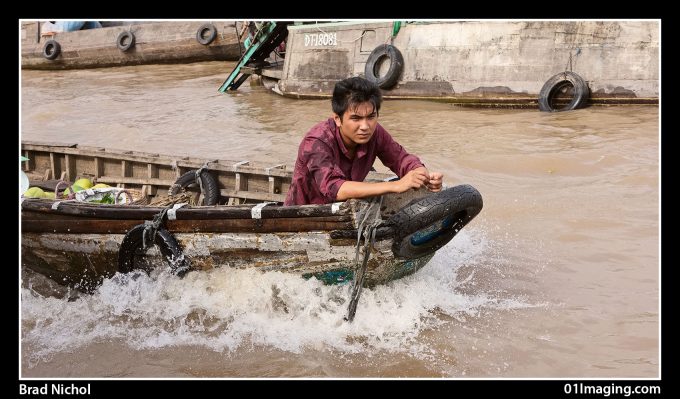
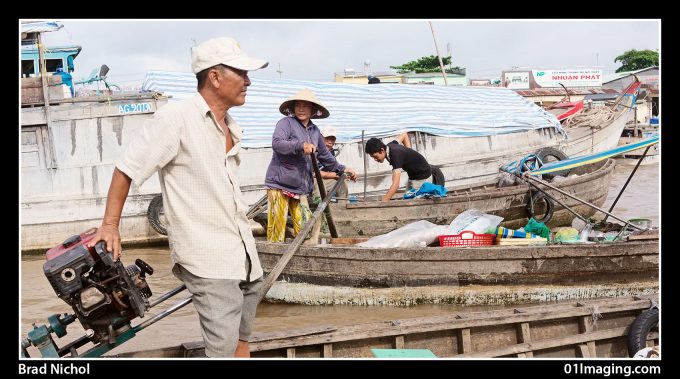
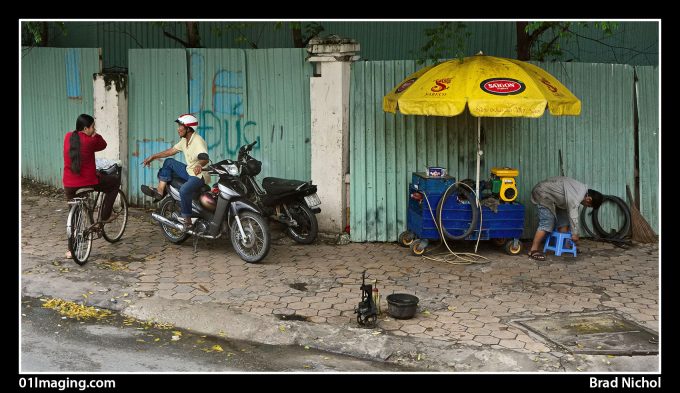
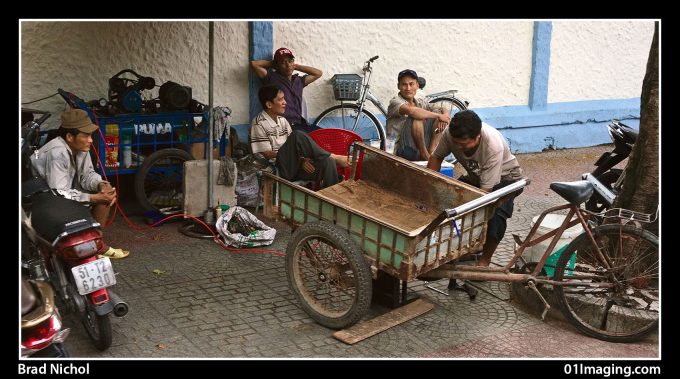
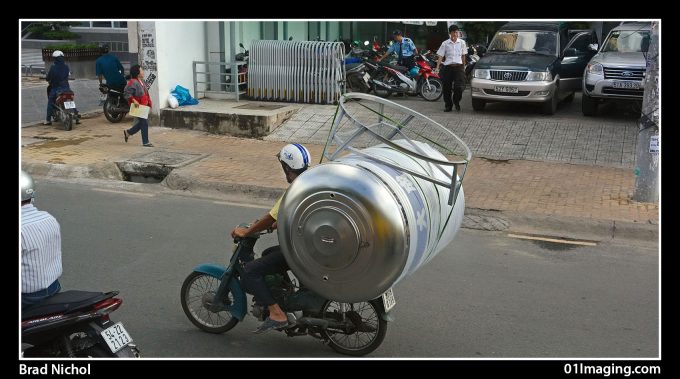
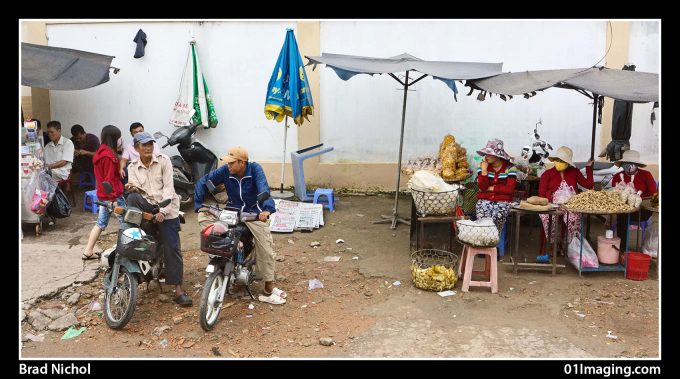
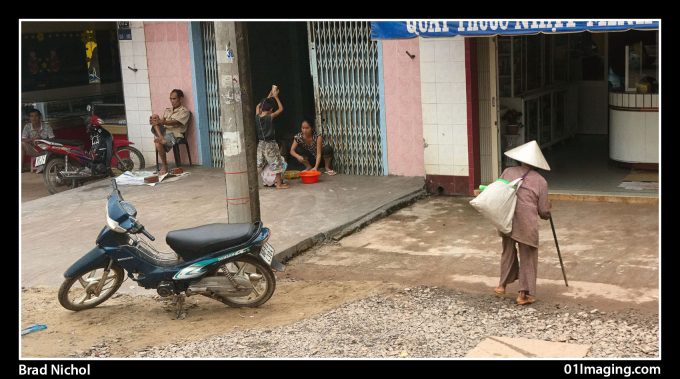
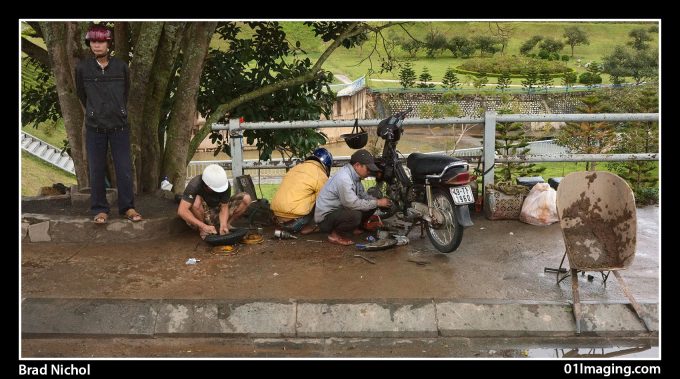
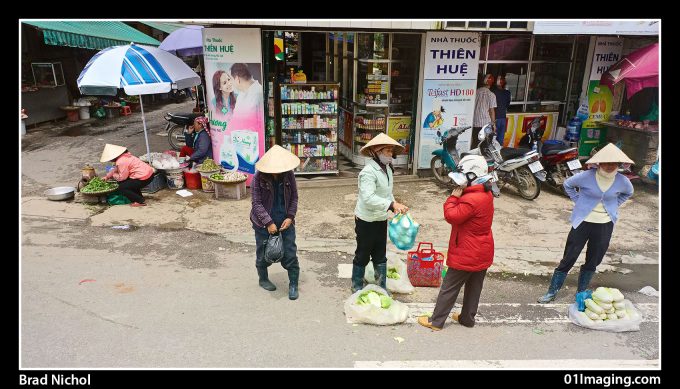
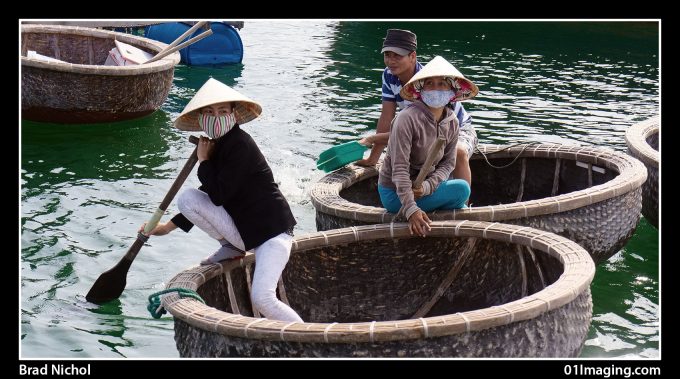
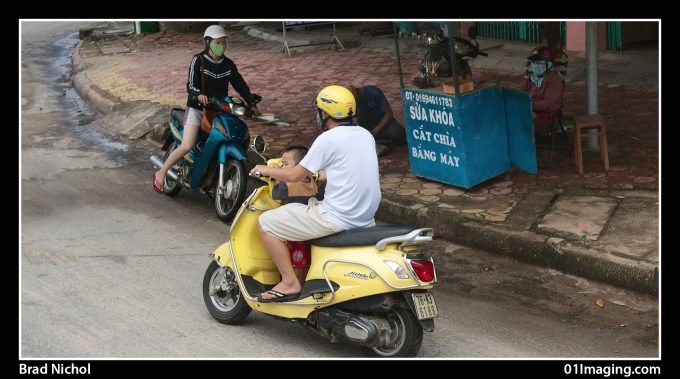
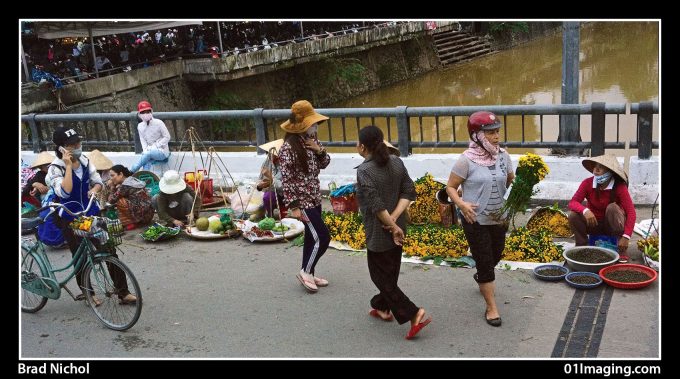
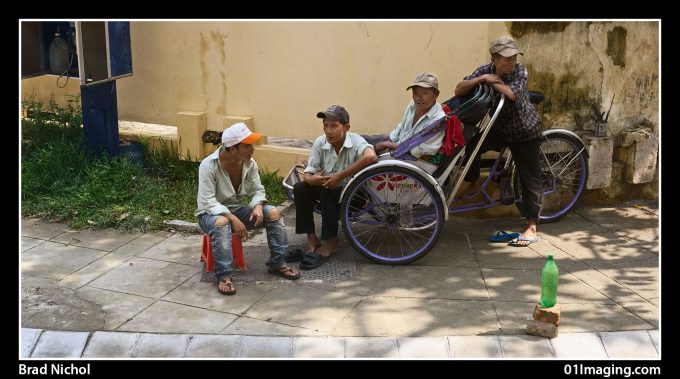
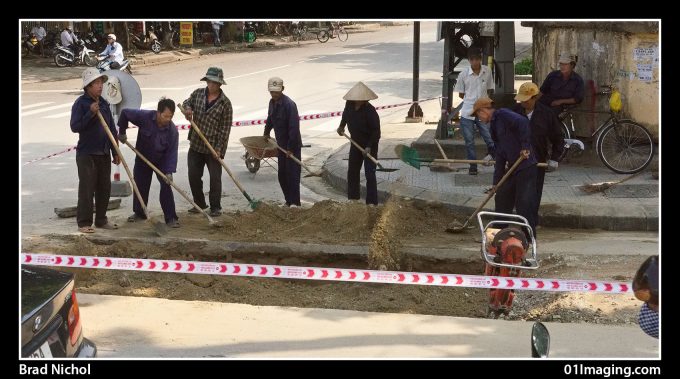
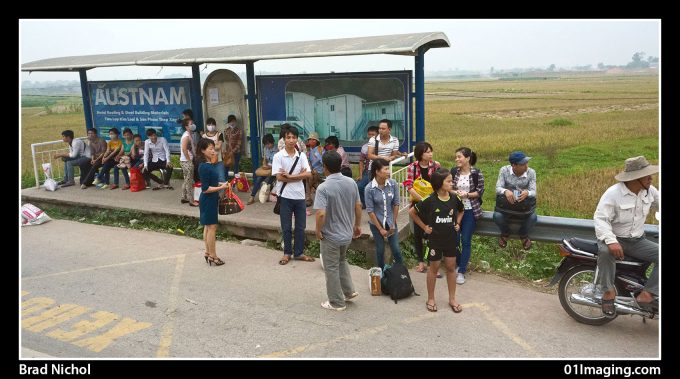
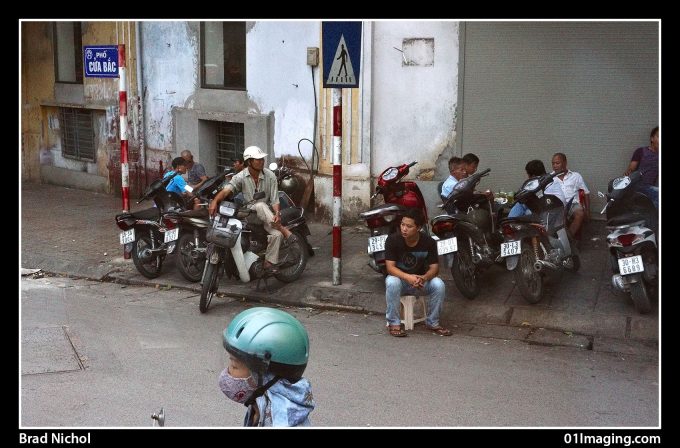
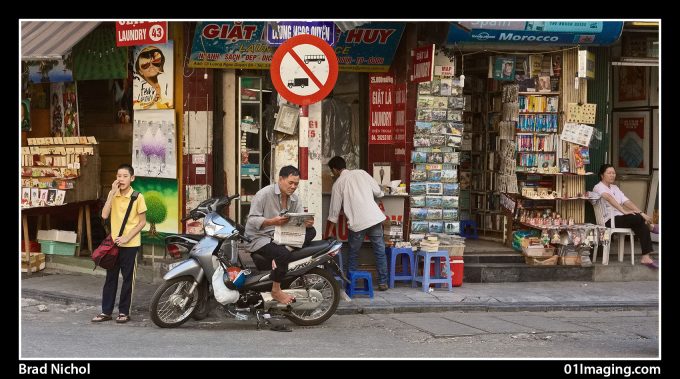
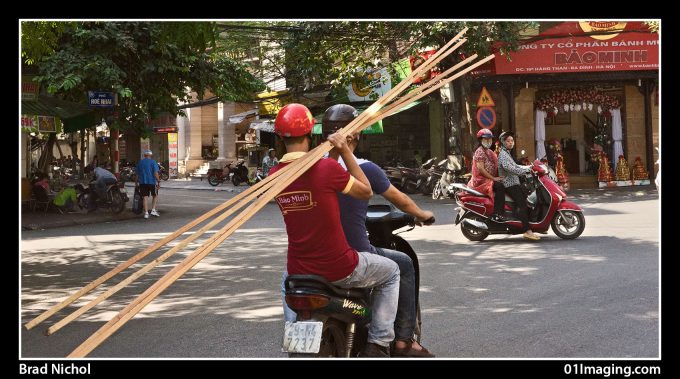
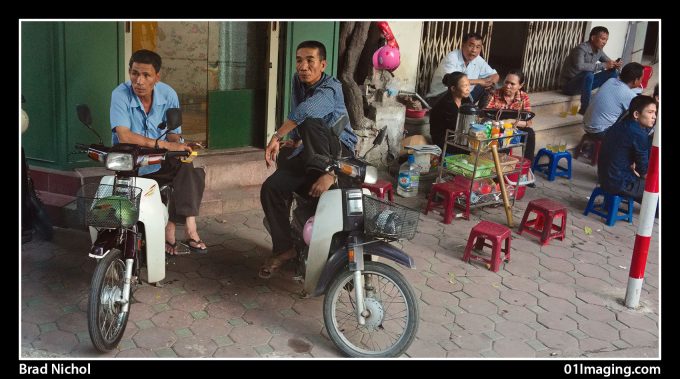
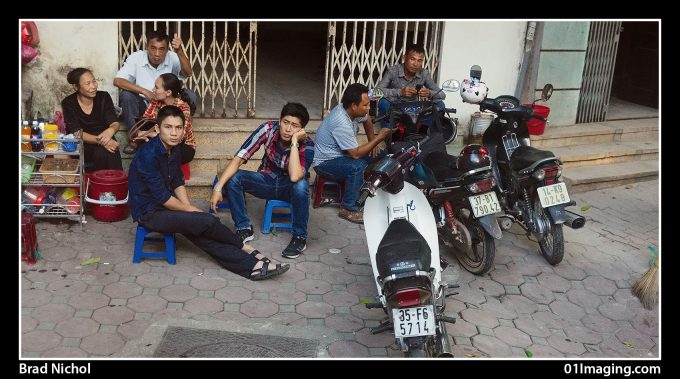
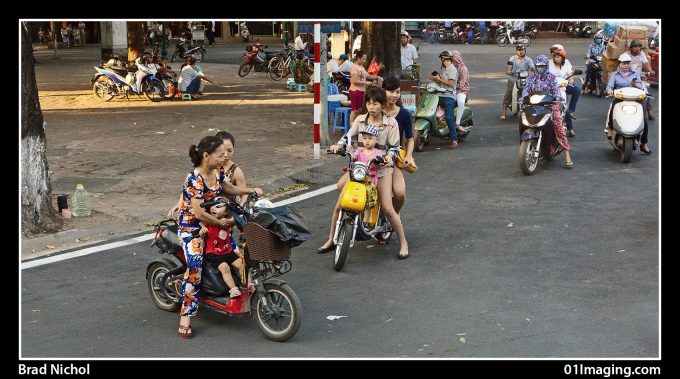
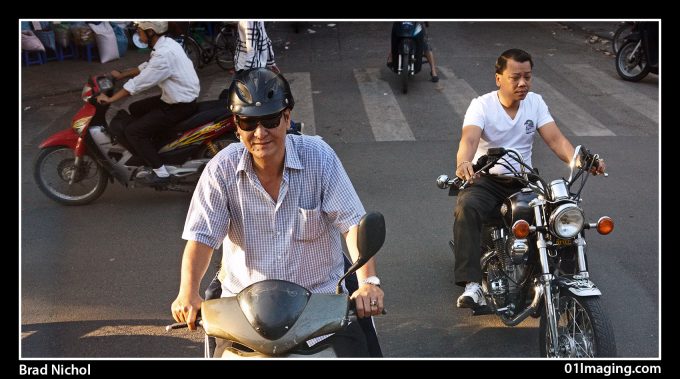


There are some interesting and nicely capurted images but I can’t help feeling that this was a wasted opportunity. You went all that way and then stayed on a bus?! Would have been far better to wander around on foot and interact with the people – that approach would have yielded a better portfolio.
These photos represent a tiny subset of the images I took, we walked throught markets, villages, visited temples, all sorts of things. Trust no opportunities were missed, this is just work captured using methods I was happy to share for those times when you are in transit and don’t wish to stop shooting. On another occasion I will likely share other sets of images from this trip.
I echo the comment about including the window frame.Otherwise nice work.
I really enjoyed your images and writing…and I use a similar technique with my 20mm f1.7.
I have way more keepers with double the depth of field at every f-stop mft v. ff.
Richard, spot on about the keeper rate, I love my M4/3 gear for this sort of photography, looking back through the thousands of images from a recent trip to Spain and Italy it amazes me just how many keepers I got thanks to the Olys EM5s extra DOF and the fabulous image stabilisation.
Great article Brad – I can totally relate to the situation and went through similar (arriving at the same conclusion/method, though opting for the RX10M2 last time). Great images and story – thoroughly enjoyed it!
Nice exercise on objectivity.
In the case that thing exist
I can only echo bgood’s comment: interesting and enjoyable. Only thing I was missing was the bus window’s frame…
P.s.: these images remind me of the few days I spent in Beijing, 18 years ago, for a conference. I sneaked out at every opportunity, FM2n, 35.2.0 and Fuji 400 colour negative loaded in hand, photographing almost everything I saw. It was cold and (hazy, yellow smog everywhere) sunny, beautiful muted light, and I walked everywhere, not understanding the street signs, but understanding the city’s grid system. As a white, reasonbly tall Westerner, I stood out like a sore thumb every time I (as I did) wandered off the main streets. I recall very friendly people, some not liking the sight of a camera.
If only I still had those negatives.
Michiel, that sounds wonderful, isn’t it great how the experience of shooting heightens our awareness and experience of a place…I’ve lost quite a few negs to sadly.
I guess you can call that street photography, literally. Sorry to say that it does get boring after the 75th motorbike or so. Seems you missed a whole lot of a beautiful country.
Enjoyable and interesting images.Good comments on technique for the shooting situation. Post processing suits my taste. Touch of humor on wife’s comments to start (ring of familiarity for many of us). Nice post. Thanks.